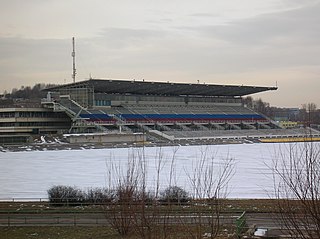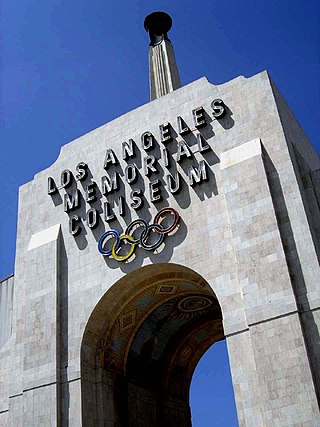
The 1936 Summer Olympics, officially known as the Games of the XI Olympiad and commonly known as Berlin 1936, was an international multi-sport event held from 1 to 16 August 1936 in Berlin, Germany. Berlin won the bid to host the Games over Barcelona at the 29th IOC Session on 26 April 1931. The 1936 Games marked the second and most recent time the International Olympic Committee gathered to vote in a city that was bidding to host those Games. Later rule modifications forbade cities hosting the bid vote from being awarded the games.

The 1932 Summer Olympics were an international multi-sport event held from July 30 to August 14, 1932, in Los Angeles, California, United States. The Games were held during the worldwide Great Depression, with some nations not traveling to Los Angeles; 37 nations competed, compared to the 46 in the 1928 Games in Amsterdam, and even then-U.S. President Herbert Hoover did not attend the Games. The organizing committee did not report the financial details of the Games, although contemporary newspapers claimed that the Games had made a profit of US$1,000,000.

Kaftanzoglio Stadium is a sports stadium in Thessaloniki, Greece. It currently has 27,770 seats, owing to conversion of terraces to seats in 2000 and a comprehensive renovation before reopening to host football matches for the 2004 Summer Olympics, which was centered in Athens. It has been the home stadium of Iraklis Thessaloniki F.C. since 1960.

The Helsinki Olympic Stadium, located in the Töölö district about 2.3 kilometres (1.4 mi) from the centre of the Finnish capital Helsinki, is the largest stadium in the country, nowadays mainly used for hosting sports events and big concerts. The stadium is best known for being the centre of activities in the 1952 Summer Olympics. During those games, it hosted athletics, equestrian show jumping, and the football finals.

The Bolt Arena is a football stadium in Helsinki, Finland. It is named after the labour hire company Bolt.Works.

Töölö Sports Hall is a sports venue located in the Töölö district of Helsinki, Finland. It was designed by Aarne Hytönen and Risto-Veikko Luukkonen and built in 1935 as Messuhalli. It is located near the Olympic Stadium, the Opera House, and the Sonera Stadium.
For the 1956 Summer Olympics, events were staged in a total of thirteen sports venues in Melbourne, Victoria, one in Ballarat, Victoria, and three sports venues in Stockholm, Sweden. The equestrian events took place in Stockholm in June 1956, due to Australia's strict quarantine laws on equestrianism, and the other Olympic events took place in Melbourne later in the year, between late November and early December.
For the 1960 Summer Olympics, a total of thirty-four sports venues were used. The Basilica of Maxentius, the Baths of Caracalla, the Appian Way, and Via Cassia were among the ancient Roman venues used for the games. The football stadium in Florence hosted the 1934 FIFA World Cup and would later host the 1990 FIFA World Cup. Stadio Olimpico would later serve host to the 1987 IAAF World Championships in Athletics and the final venue for the 1990 FIFA World Cup. The marathon would be lit at night by Italian soldiers holding torches that included the Appian Way with a finish at the Arch of Constantine.
For the 1964 Summer Olympics, a total of thirty-three sports venues were used. Six of the venues were built before the International Olympic Committee awarded the 1964 Games to Tokyo in 1959. This included two venues that hosted the 1958 Asian Games. There were thirteen new, eight temporary, and five reconstructed and/or renovated venues that were used during the event. During the Olympics, wind and weather had issues with two athletic events. After the Olympics, one venue hosted both a FIFA World Cup and a World Athletics Championship event while another also hosted a World Athletics Championship event.

For the 1968 Summer Olympics, a total of twenty-five sports venues were used. Most of the venues were constructed after Mexico City was awarded the 1968 Games. Mexican efforts in determining wind measurement led to sixteen world records in athletics at the University Olympic Stadium. All four of the football venues used for these games would also be used for both of the occurrences that Mexico hosted the FIFA World Cup, in 1970 and 1986.

For the 1980 Summer Olympics, a total of twenty-eight sports venues were used. The first venue used for the Games was built in 1923. With the creation of the Spartakiad in Moscow in 1928, more venues were constructed. Central Lenin Stadium Grand Arena was built in 1956 for that year's versions of the Spartkiad. A plan in 1971 to construct more sports venues by 1990 was initiated, but accelerated in 1974 when Moscow was awarded the 1980 Games. The new venues to be used for the Games were completed in 1979. During the Games themselves at the permanent road cycling venue, the first ever constructed, the largest margin of victory was recorded in the individual road race cycling event since 1928. The Grand Arena hosted the football final that was played in a rainstorm for the third straight Olympics. After the 1991 break of the Soviet Union, the venues in Kiev, Minsk, and Tallinn would be located in Ukraine, Belarus, and Estonia, respectively. Luzhniki Stadium, formerly Grand Arena, continues to be used, and it was affected by the Luzhniki disaster in 1982. The stadium served as host for the IAAF World Championships in Athletics in 2013. Another venue, the Moscow Canoeing and Rowing Basin, served as host to the ICF Canoe Sprint World Championships in 2014. In December 2010, Russia was awarded the 2018 FIFA World Cup with Luzhniki Stadium and Dynamo Stadium proposed as venues for those events.

For the 1984 Summer Olympics, a total of thirty-one venues were used. The Los Angeles Memorial Coliseum and the Rose Bowl, two venues previously used for the 1932 Summer Olympics, were used for the 1984 Games. Between the 1932 and the 1984 Summer Olympics, the expansion of professional sports teams assisted in the growth of the facilities that would be used for the 1984 events. Only two new permanent venues were constructed, both using corporate sponsorship, though neither were mentioned in the official Olympic report. Many other venues had temporary adjustments and returned to their normal usage once the 1984 Olympics were completed. Stanford Stadium in Palo Alto and the Rose Bowl later served as venues for the Super Bowl, the FIFA World Cup, and the FIFA Women's World Cup.

For the 2004 Summer Olympics, a total of thirty-five sports venues were used. Athens hosted the first modern Olympic Games in 1896, which used venues such as Panathinaiko Stadium and the city of Marathon for which the long-distance race would be named. From the end of the 1896 Games until the late 1970s, Greece underwent numerous political changes that included the Balkan Wars, two World Wars, a civil war, and a military coup that resulted in a junta that lasted from 1967 to 1974. A change in democracy in 1975 resulted in Greece's admission into the European Economic Community in 1979.










